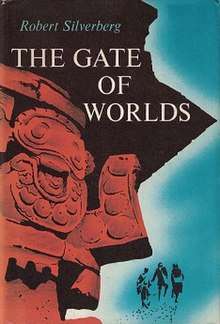The Gate of Worlds
The Gate of Worlds is an alternate history novel by American writer Robert Silverberg. It was first published by Holt, Rinehart & Winston in the United States in 1967. The first UK hardcover edition was published by Gollancz in 1978.[1]
 First edition (US) | |
| Author | Robert Silverberg |
|---|---|
| Cover artist | H. Lawrence Hoffman |
| Country | United States |
| Language | English |
| Genre | Science fiction |
| Publisher | Holt, Rinehart & Winston |
Publication date | 1967 |
| Media type | Print (hardcover) |
| Pages | 244 pp |
| Followed by | Beyond the Gate of Worlds (short stories) |
Plot summary
The Black Death killed three fourths of the European population, delaying progress and, ultimately, the Industrial Revolution. Most of Central Europe was conquered by the Ottoman Empire, which occupied it until the twentieth century, leaving it in no shape for colonization of much of the non-European world as in our timeline. Constantinople was conquered in 1420, the Ottomans moved into Vienna in 1440, and took over Paris in 1460, before invading the British Isles in 1490.
The greater virulence of the Black Death in Europe allowed non-European powers to emerge. These included the Aztecs and Incas in Central America and South America, given that Europeans only 'discovered' the Americas in 1585 through an inadvertent Portuguese expedition. In Eastern Asia, Russia and Japan are now the main powers. By contrast, Turkey has undergone a period of instability that cost it control over England, from which it was expelled in the early twentieth century due to the leadership of a new royal dynasty inaugurated by "James the Valiant."
Evidently, William Shakespeare's ancestors survived the epidemic, although Shakespeare wrote his histories, tragedies and comedies in the Turkish language, set in the Ottoman Empire milieu of England's new Muslim masters.
The narrator and protagonist is eighteen-year-old Dan Beauchamp, who travels from impoverished England in 1967 to seek his fortune in the Aztec Empire. Along his way, he is accompanied by Aztec philosopher Quequex.
Sequel
In 1991, Silverberg edited a thematic sequel to The Gate of Worlds, entitled Beyond the Gate of Worlds, consisting of three short stories that are set in the same fictional universe, and further explore its non-western multipolar world and its international relationships. Silverberg himself contributed the lead tale, "Lion Time in Timbuctoo," while John Brunner and Chelsea Quinn Yarbro also contributed stories.
Similar works
Thematically, and given that it also occurs in a divergent timeline that originated in the context of a more virulent fourteenth century Black Death than our own, the (2002) novel by Kim Stanley Robinson The Years of Rice and Salt uses a similar literary device to consider the impact on global history of a less dominant Europe. However, in Robinson's analogous post-pandemic timeline, Europe never recovered from its decimation at the time of the epidemic, and India's Mughal Empire retains its ascendancy, as do the empires of China, Persia and the Ottomans, North America's Iroquois confederation, the Aztec and Inca empires and other inhabitants of this multipolar world.
Like Silverberg's alternate history, Muslim civilization declines during the alternate 19th to 20th centuries, leading to the triumphs of China and India during a decades-long 20th-century global war. Unlike Silverberg's world, there is comparable technological progress to our own timeline, due to that prolonged multipolar global war. By its early 21st century, Robinson's world has aircraft, information technology, and potential access to nuclear weapons.
Still another novel using a similar theme is Harry Turtledove's In High Places. In that timeline, the impact of the Black Death is somewhere in between those envisioned by Siverberg and Robinson. In this depiction, Christian Europe is weakened by the plague, enabling the Muslims to conquer Spain, Italy and South France - but they are then blocked by the resistance of the remaining Christian powers, emboldened by a militant new form of Christianity centering on Henri, "The Second Son of God". Like in Silverberg's book, England is this timeline is a backwater which never amounted to much, and there was no tide of European overseas expansion and colonization. However, by the Twentieth Century, both Christians and Muslims have reached America, and are busy colonizing it, in conflict both with its natives and with each other.
References
- Majipoor.com, the Quasi-Official Robert Silverberg Web Site
